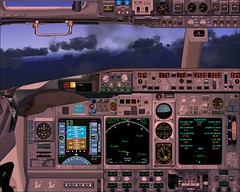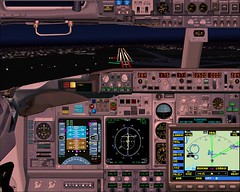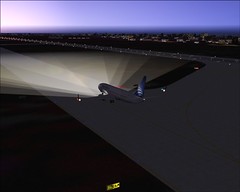Aircraft: Boeing 737-800 (POSKY v0.8 FDE) with Copa Airlines livery
Simulator: Microsoft Flight Simulator 2004 SP1
Flight Number: 4150
Departure: Schiphol airport, Amsterdam, The Netherlands (EHAM / AMS) UTC+1
Destination: Dublin airport, Ireland (EIDW / DUB) UTC
Expected time: 05: 25 - 06:45
Distance: 465 nm
Cruise altitude: FL320
Route: EHAM SUPUR OTBED PENIL BAGSO ROKNA LORKO EIDW
Charts: EHAM departure charts, EIDW ILS approach charts (all runways)
Amsterdam 05:05
The crew has boarded the aircraft and your virtual captain (me) is busy setting up the instruments on the cockpit. This would be my 2nd airliner flight in 5 months due to some personal issues. It is very early in this dark Winter morning.
It was so early that Schiphol delivery (EHAM_DEL) did not respond to my call. I switched back to the Ground frequency (EHAM_N_GND) who tried to contact clearance. Having failed GND examined my flight plan (IFR to Dublin via BORG 1 Sierra departure) and approved it. Then Clearance came from his toilet break or whatever but it was too late. I did some final checks and arrangements in my virtual cockpit. I turned on the strobes, beacons and released the brakes.
Contacted EHAM_GND which gave us oké for pushback from Gate B62 and startup. Having done that a few minutes later we informed we were ready to taxi. GND gave us permission to taxi to runway 24 via ALPHA-1, ALPHA, SIERRA, ALPHA-27, WHISKEY-7. I turned on the runway turnoff lights. We are carrying 31230 pounds of cargo and 162 virtual passengers eager to have fun in Dublin.
We started taxiing to the runway and the problems started! the avionics stopped working, my EICAS, EHSI and GPS appear out of order. I struggled frantically for quite some time, we were late as it was. I informed GND about the technical issues and just when the captain (me) was about to request permission to return to the gate for repairs I found out how to turn on the master avionics switch (apparently not on this cockpit panel!!!). Systems appeared operational.
We continued to the holding point and switched over to Schiphol TOWER having set our transponder to squawk code 6265. We were cleared to line up and take off and contact Schiphol Approach when passing 1000 feet.
Lined up to runway 24, still very dark outside but good weather. Takeoff flaps configuration set, auto-brakes set to RTO (Reject Take Off), turned on landing lights. Autopilot configured for the initial climb. The captain applied the brakes, increased throttle to 70% N1 and when engines were stable full throttle was applied and the brakes released. The aircraft accelerated over the runway, this were tense moments but very exciting!
V1... Rotate! nose pitched up 10 degrees. Positive climb attained, gear up. Passed 1000' started flaps retraction schedule, switched over to Schiphol Approach. We are cleared to climb to cruise altitude and we turn right heading 254 degrees for our BERGI 2 XRAY departure (SID).
Initial Climb
We reached BERGI intersection just off the coast of The Netherlands and turned left
 heading 299 degrees inbound SUPUR on airway UL602. Switched altimeter setting to standard (2992) passing the transition altitude (3000' in The Netherlands). Autothrottle is enabled, Autopilot set to maintain the climb profile to cruise altitude at +1800 feet/minute holding 240 knots under 10000'.
heading 299 degrees inbound SUPUR on airway UL602. Switched altimeter setting to standard (2992) passing the transition altitude (3000' in The Netherlands). Autothrottle is enabled, Autopilot set to maintain the climb profile to cruise altitude at +1800 feet/minute holding 240 knots under 10000'.Passing 10000' the landing lights were turned off and accelerated beyond 250 knots to continue the climb.
Cruise FL320
 We were cruising at FL320 at the expected schedule but somehow we lost didn't go fast enough. There were some beautiful views from outside the cockpit such as this one with the blue skies above the high clouds. There was another with the half moon on the tail of the plane but I did not upload that one.
We were cruising at FL320 at the expected schedule but somehow we lost didn't go fast enough. There were some beautiful views from outside the cockpit such as this one with the blue skies above the high clouds. There was another with the half moon on the tail of the plane but I did not upload that one.The virtual captain used the peace of cruise altitude (luckily no problems had arised). The autopilot was engaged and while the captain monitored the instruments he also studied all over again the Dublin approach charts.
Descent

According to the calculations we should initiate our descent some 71 nm inbound to DUBLIN VOR in order to be at our Initial Approach Fix (IAF) ROKNA at 3000 feet. I programmed the autopilot for the desired bottom of descent but made the mistake of setting vertical speed to only -1800 feet/minute. Speed however was set so that we would be at or below 250 knots when reaching 10000'.
Landing lights were turned on at 10,000'. Due to the descent error we were still too high on the IAF, in fact 10000'! therefore the captain had to fly a holding pattern in order to lose the necessary altitude to initiate the approach. The photo shows that the skies had already cleared (beautiful, heh?) and at this point we were flying 3500' with tail winds about to make a sharp turn towards LORKO for our final approach. Very exciting, landings are nice but stressful time even in PC simulation. There was no air traffic controller coverage in this airspace on IVAO but anyway, we had charts and if necessary the Garmin GPS 500 to load approach vectors.
Final Approach
 We crossed the final approach LORKO and by now we were on finals to runway 28 at Dublin. Right here the (virtual) captain was a bit stressed considering this was his 2nd airliner landing in a long time.
We crossed the final approach LORKO and by now we were on finals to runway 28 at Dublin. Right here the (virtual) captain was a bit stressed considering this was his 2nd airliner landing in a long time.We were established on the localizer just slighly off center (great alignment for so much time out of service!) with some slight cross winds. Not only are we properly aligned, we are also on the glideslope. The cockpit's ground proximity warning (I installed it on this panel) was already calling out "50 feet" and the inner marker of the ILS had lighted up.
Landed
 It was a perfect landing! and a very exciting one, the only thing that beats an ILS landing in night conditions is when it is day but with bad weather (had that landing in Copenhagen).
It was a perfect landing! and a very exciting one, the only thing that beats an ILS landing in night conditions is when it is day but with bad weather (had that landing in Copenhagen).We vacated the runway and turned right to taxi via ECHO-7 BRAVO-6,BRAVO-4,BRAVO-3 to the gates at Dublin international airport.
The pilot closed the flight plan, turned off the engines, cleared the seat belt signs, turned off lights and opened the doors. The crew had already wished the best to our passengers which were sleepy but enjoyed a good flight (albeit a bit late due to the slower cruise speed). Today they were going to have some hearty Shepherd's Pie and some Guiness or Murphy's Red beer.
The captain however was going to spend some time collecting charts and preparing his next flight from Amsterdam to Madrid (same aircraft) later on that week. For that reason the captain was going to be ferried back to Amsterdam.
Full size photos of this virtual flight can be found at Flickr. Search for the photos that begin with "AMS-DUB"
No comments:
Post a Comment